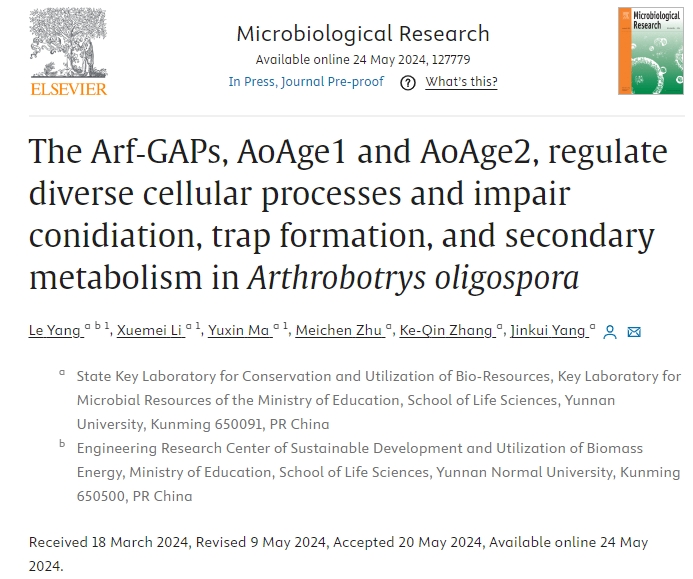博文
云师大生命科学学杨乐博士在TOP期刊《Microbiological Research》发表最新成果
||
2024年5月24日,Elsevier 旗下国际著名期刊《Microbiological Research》在线发表了云南师范大学生命科学学院杨磊博士最新研究成果《The Arf‐GAPs, AoAge1 and AoAge2, regulate diverse cellular processes and impair conidiation, trap formation, and secondary metabolism in Arthrobotrys oligospora》。云南师范大学生命科学学院杨乐博士为第一作者,通讯作者为云南大学生科学院杨金奎教授。
https://www.sciencedirect.com/science/article/pii/S0944501324001800#fig0005

Abstract
Guanine nucleotide-binding proteins of the ADP ribosylation factor (Arf) family and their activating proteins (Arf-GAPs) are essential for diverse biological processes. Here, two homologous Arf-GAPs, Age1 (AoAge1) and Age2 (AoAge2), were identified in the widespread nematode-trapping fungus Arthrobotrys oligospora. Our results demonstrated that AoAge1, especially AoAge2, played crucial roles in mycelial growth, sporulation, trap production, stress response, mitochondrial activity, DNA damage, endocytosis, reactive oxygen species production, and autophagy. Notably, transcriptome data revealed that approximately 62.7% of the genes were directly or indirectly regulated by AoAge2, and dysregulated genes in Aoage2 deletion were enriched in metabolism, ribosome biogenesis, secondary metabolite biosynthesis, and autophagy. Furthermore, Aoage2 inactivation caused a substantial reduction in several compounds compared to the wild-type strain. Based on these results, a regulatory network for AoAge1 and AoAge2 was proposed and verified using a yeast two-hybrid assay. Based on our findings, AoAge1 and AoAge2 are essential for vegetative growth and mycelial development. Specifically, AoAge2 is required for sporulation and trapping morphogenesis. Our results demonstrated the critical functions of AoAge1 and AoAge2 in mycelial growth, diverse cellular processes, and pathogenicity, offering deep insights into the functions and regulatory mechanisms of Arf-GAPs in nematode-trapping fungi.
https://blog.sciencenet.cn/blog-454141-1435590.html
上一篇:云师大地理学部罗毅教授在top期刊《Ecological Indicators》上发表研究成果
下一篇:云师大生命科学学院王娟博士在TOP期刊《The Plant Journal 》发表最新成果